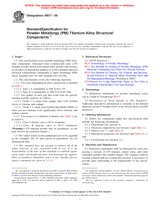We need your consent to use the individual data so that you can see information about your interests, among other things. Click "OK" to give your consent.
ASTM B817-08
Standard Specification for Powder Metallurgy (PM) Titanium Alloy Structural Components (Withdrawn 2013)
Automatically translated name:
Standard Specification for Powder Metallurgy (P/M) Titanium Alloy Structural Components
STANDARD published on 1.11.2008
The information about the standard:
Designation standards: ASTM B817-08
Note: WITHDRAWN
Publication date standards: 1.11.2008
SKU: NS-8259
The number of pages: 3
Approximate weight : 9 g (0.02 lbs)
Country: American technical standard
Category: Technical standards ASTM
Annotation of standard text ASTM B817-08 :
Keywords:
compaction, cold isostatic pressing (CIP), ELCL titanium, HDH titanium powder, hot isostatic pressing (HIP), powder metallurgy, ´sponge fines´ titanium powder, structural components, Ti-6A1-4V, Ti-6A1-6V-2Sn, titanium, titanium alloys, vacuum sinter, Powder metallurgy (P/M) materials--specifications, Structural metals/alloys--specifications, Titanium (Ti)/alloys--specifications, ICS Number Code 77.120.50 (Titanium and titanium alloys), 77.160 (Powder metallurgy)
Additional information
| 1. Scope | ||||||||
|
1.1 This specification covers powder metallurgy (PM) structural components fabricated from commercially pure (CP) titanium powder mixed with master alloy powder and elemental powders in appropriate quantity to yield combined material chemical compositions comparable to ingot metallurgy (I/M) alloys Titanium 6A1-4V and Titanium 6A1-6V-2Sn. 1.2 This specification covers the following materials: 1.2.1 Two types depending on alloy composition as detailed in Table 1. 1.2.1.1 Type I is comparable to I/M Ti-6A1-4V. 1.2.1.2 Type II is comparable to I/M Ti-6A1-6V-2Sn. 1.2.2 Two grades of each type that result from the specific titanium powder used are as follows: 1.2.2.1 Grade 1 is made from sponge fines with residual levels of chlorine and sodium. 1.2.2.2 Grade 2 is made from hydride/dehydride (HDH) or other process titanium with significantly lower chlorine and sodium content. 1.2.3 Two classes as a function of density (see Table 2) are as follows: 1.2.3.1 Class A density ratio is 94 % minimum. 1.2.3.2 Class B density ratio is 99 % minimum. (Warning—CP titanium powder may be pyrophoric; its use may involve an explosion hazard.) 1.3 The values stated in inch-pound units are to be regarded as the standard. The SI units given in parentheses are for information only. 1.4 This standard does not purport to address all of the safety concerns, if any, associated with its use. It is the responsibility of the user of this standard to establish appropriate safety and health practices and determine the applicability of regulatory limitations prior to use. Specific precautionary statements are given in 1.2.3.2. |
||||||||
| 2. Referenced Documents | ||||||||
|
We recommend:
Technical standards updating
Do you want to make sure you use only the valid technical standards?
We can offer you a solution which will provide you a monthly overview concerning the updating of standards which you use.
Would you like to know more? Look at this page.




 Cookies
Cookies
